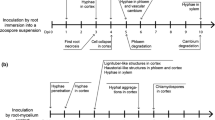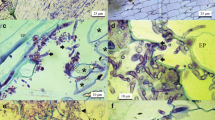Abstract
The histology of root rot of flax seedlings infected by Fusarium oxysporum f.sp. lini was studied using semi-thin sections of plastic-embedded roots. Within two days, the fungus colonised the root cap cell layers by intercellular and intracellular growth. Attempted intercellular penetration of root cap cells via the middle lamella induced the formation of appositions next to penetrating hyphae. Other cells next to invading hyphae collapsed, which was accompanied by swelling of the cells neighbouring the collapsing cells. Invasion of the root cap and growth towards the protodermis seemed retarded to some extent by the natural sloughing off of root cap cell layers. The protodermis and cortex were reached and penetrated in four days, which was followed by rapid and massive colonisation of the entire root tip. The protoxylem was reached in eight days. From eight to sixteen days after inoculation, the lower parts of the roots were colonised throughout and the cortical region was degraded. Colonised tissues were severely plasmolyzed. Heavily colonised roots were hollowed out, the only remaining tissues being the epidermis and exodermis outside, and remainders of the colonised xylem inside. Upward spread of root rot was restricted in the period studied to the first 10 mm from the root tip, the upper parts of the root and the hypocotyl being unaffected except for invasion through lateral roots infected at their respective tips. Mature roots with a well-developed epidermis and exodermis were not invaded from outside. Disease development was similar in partially resistant ‘Hermes’ and susceptible ‘Regina’, except for rot development that was consistently slightly more extensive in the susceptible cultivar. Distinct extravascular resistance factors were not detected in ‘Hermes’, suggesting that extravascular resistance in flax to F. oxysporum f.sp. lini is of a quantitative nature.
Similar content being viewed by others
References
Baayen RP (1992) Resistance mechanisms of plants to rot and wilt diseases caused by Fusarium oxysporum. Acta Horticulturae 325: 675-682
Baayen RP (1996) Afweermechanismen bij lelie tegen aantasting door Fusarium oxysporum. Report 96-03, DLO Research Institute for Plant Protection, Wageningen, The Netherlands, pp. 33
Baayen RP, Ouellette GB and Rioux D (1996) Compartmentalization of decay in carnations resistant to Fusarium oxysporumf. sp. dianthi. Phytopathology 86: 1018-1029
Baayen RP, Van Eijk C and Elgersma DM (1989) Histology of roots of resistant and susceptible carnation cultivars from soil infested with Fusarium oxysporumf. sp. dianthi. Netherlands Journal of Plant Pathology 95: 3-13
Benhamou N, Fortin JA, Hamel C, St-Arnaud M and Shatilla A (1994) Resistance responses of mycorrhizal Ri T-DNA-transformed carrot roots to infection by Fusarium oxysporumf. sp. chrysanthemi. Phytopathology 84: 958-968
Bishop CD and Cooper RM (1983) An ultrastructural study of root invasion in three vascular wilt diseases. Physiological Plant Pathology 22: 15-27
Boyle LW (1934) Histological characters of flax roots in relation to resistance to wilt and root rot. Technical Bulletin, United States Department of Agriculture, Washington, D. C., 458: 1-18
Clark G (1981) Staining procedures. Fourth edition. Williams and Wilkins, Baltimore, USA, pp. 512
Jensen WA (1962) Botanical histochemistry. W. H. Freeman and Co., San Francisco, USA, pp. 408
Krishnamurthy KV (1988) Methods in plant histochemistry. S. Viswanathan Printers and Publishers, Chetput, Madras, India, pp. 104
Kroes GMLW (1997) Aspects of resistance in flax and linseed (Linum usitatissimum) to Fusarium oxysporumf. sp. lini. PhD thesis, Wageningen Agricultural University, The Netherlands, pp. 159
Kroes GMLW, Sommers E and Lange W (1998) Two in vitroassays to evaluate resistance in Linum usitatissimumto Fusariumwilt disease. European Journal of Plant Pathology 104 (in press)
Millikan CR (1951) Diseases of flax and linseed. Technical Bulletin 9, Department of Agriculture Victoria, Australia, pp. 140
Murashige T and Skoog F (1962) A revised medium for rapid assays with tobacco tissue cultures. Physiologia Plantarum 15: 473-497
Nair PN (1956) Factors affecting resistance of flax to Fusarium lini,Bolley. PhD thesis, University of Minnesota, USA, pp. 90
Nair PN and Kommedahl T (1957) The establishment and growth of Fusarium liniin flax tissues. Phytopathology 47: 25 (abstract)
O'Brien TP and McCully ME (1981) The study of plant structure; Principles and selected methods. Thermacarphi Pty. Ltd., Melbourne, Australia, pp. 280
Tisdale WH (1917) Flaxwilt: a study of the nature and inheritance of wilt resistance. Journal of Agricultural Research 11: 573-606
Turlier MF, Eparvier A and Alabouvette C (1994) Early dynamic interactions between Fusarium oxysporumf. sp. liniand the roots of Linum usitatissimumas revealed by transgenic GUS-marked hyphae. Canadian Journal of Botany 72: 1605-1612
Author information
Authors and Affiliations
Rights and permissions
About this article
Cite this article
Kroes, G., Baayen, R. & Lange, W. Histology of root rot of flax seedlings (Linum usitatissimum) infected by Fusarium oxysporum f.sp. lini. European Journal of Plant Pathology 104, 725–736 (1998). https://doi.org/10.1023/A:1008604417614
Issue Date:
DOI: https://doi.org/10.1023/A:1008604417614




